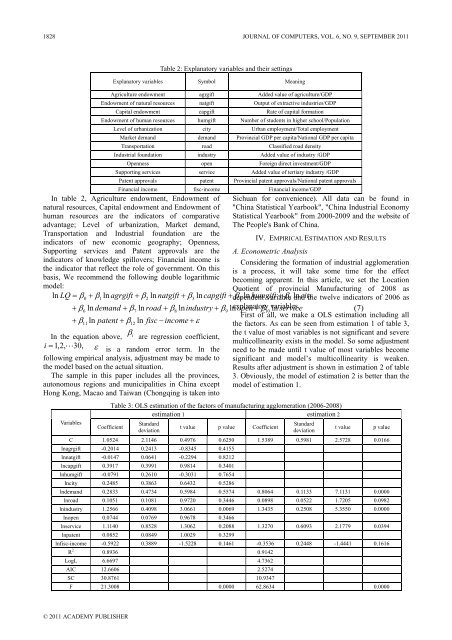Journal of Computers - Academy Publisher
Journal of Computers - Academy Publisher
Journal of Computers - Academy Publisher
Create successful ePaper yourself
Turn your PDF publications into a flip-book with our unique Google optimized e-Paper software.
1828 JOURNAL OF COMPUTERS, VOL. 6, NO. 9, SEPTEMBER 2011<br />
Table 2: Explanatory variables and their settings<br />
Explanatory variables Symbol Meaning<br />
Agriculture endowment agrgift Added value <strong>of</strong> agriculture/GDP<br />
Endowment <strong>of</strong> natural resources natgift Output <strong>of</strong> extractive industries/GDP<br />
Capital endowment capgift Rate <strong>of</strong> capital formation<br />
Endowment <strong>of</strong> human resources humgift Number <strong>of</strong> students in higher school/Population<br />
Level <strong>of</strong> urbanization city Urban employment/Total employment<br />
Market demand demand Provincial GDP per capita/National GDP per capita<br />
Transportation road Classified road density<br />
Industrial foundation industry Added value <strong>of</strong> industry /GDP<br />
Openness open Foreign direct investment/GDP<br />
Supporting services service Added value <strong>of</strong> tertiary industry /GDP<br />
Patent approvals patent Provincial patent approvals/National patent approvals<br />
Financial income fisc-income Financial income/GDP<br />
In table 2, Agriculture endowment, Endowment <strong>of</strong><br />
natural resources, Capital endowment and Endowment <strong>of</strong><br />
human resources are the indicators <strong>of</strong> comparative<br />
advantage; Level <strong>of</strong> urbanization, Market demand,<br />
Transportation and Industrial foundation are the<br />
indicators <strong>of</strong> new economic geography; Openness,<br />
Supporting services and Patent approvals are the<br />
indicators <strong>of</strong> knowledge spillovers; Financial income is<br />
the indicator that reflect the role <strong>of</strong> government. On this<br />
basis, We recommend the following double logarithmic<br />
model:<br />
ln LQ = β0<br />
+ β1<br />
ln agrgift + β2<br />
ln natgift + β3<br />
ln capgift<br />
+ β6<br />
ln demand + β7<br />
ln road + β8<br />
lnindustry<br />
+ β9<br />
+ β11<br />
ln patent + β12<br />
ln fisc − income + ε<br />
β<br />
In the equation above, i are regression coefficient,<br />
i = 1, 2,<br />
⋅⋅<br />
⋅30,<br />
ε is a random error term. In the<br />
following empirical analysis, adjustment may be made to<br />
the model based on the actual situation.<br />
The sample in this paper includes all the provinces,<br />
autonomous regions and municipalities in China except<br />
Hong Kong, Macao and Taiwan (Chongqing is taken into<br />
Sichuan for convenience). All data can be found in<br />
"China Statistical Yearbook", "China Industrial Economy<br />
Statistical Yearbook" from 2000-2009 and the website <strong>of</strong><br />
The People's Bank <strong>of</strong> China.<br />
IV. EMPIRICAL ESTIMATION AND RESULTS<br />
A. Econometric Analysis<br />
Considering the formation <strong>of</strong> industrial agglomeration<br />
is a process, it will take some time for the effect<br />
becoming apparent. In this article, we set the Location<br />
Quotient <strong>of</strong> provincial Manufacturing <strong>of</strong> 2008 as<br />
+ dependent β4<br />
ln humgift variable + β5<br />
ln and city the twelve indicators <strong>of</strong> 2006 as<br />
lnexplanatory<br />
open + β variables.<br />
10 ln service<br />
( 7)<br />
First <strong>of</strong> all, we make a OLS estimation including all<br />
the factors. As can be seen from estimation 1 <strong>of</strong> table 3,<br />
the t value <strong>of</strong> most variables is not significant and severe<br />
multicollinearity exists in the model. So some adjustment<br />
need to be made until t value <strong>of</strong> most variables become<br />
significant and model’s multicollinearity is weaken.<br />
Results after adjustment is shown in estimation 2 <strong>of</strong> table<br />
3. Obviously, the model <strong>of</strong> estimation 2 is better than the<br />
model <strong>of</strong> estimation 1.<br />
Table 3: OLS estimation <strong>of</strong> the factors <strong>of</strong> manufacturing agglomeration (2006-2008)<br />
estimation 1 estimation 2<br />
Variables<br />
Coefficient<br />
Standard<br />
deviation<br />
t value p value Coefficient<br />
Standard<br />
deviation<br />
t value p value<br />
C 1.0524 2.1146 0.4976 0.6250 1.5389 0.5981 2.5728 0.0166<br />
lnagrgift -0.2014 0.2413 -0.8345 0.4155<br />
lnnatgift -0.0147 0.0641 -0.2294 0.8212<br />
lncapgift 0.3917 0.3991 0.9814 0.3401<br />
lnhumgift -0.0791 0.2610 -0.3031 0.7654<br />
lncity 0.2485 0.3863 0.6432 0.5286<br />
lndemand 0.2833 0.4734 0.5984 0.5574 0.8064 0.1133 7.1131 0.0000<br />
lnroad 0.1051 0.1081 0.9720 0.3446 0.0898 0.0522 1.7205 0.0982<br />
lnindustry 1.2566 0.4098 3.0661 0.0069 1.3435 0.2508 5.3550 0.0000<br />
lnopen 0.0744 0.0769 0.9678 0.3466<br />
lnservice 1.1140 0.8528 1.3062 0.2088 1.3270 0.6093 2.1779 0.0394<br />
lnpatent 0.0852 0.0849 1.0029 0.3299<br />
lnfisc-income -0.5922 0.3889 -1.5228 0.1461 -0.3536 0.2448 -1.4441 0.1616<br />
R 2 0.8936 0.9142<br />
LogL 6.6697 4.7362<br />
AIC 12.6606 2.5274<br />
SC 30.8761 10.9347<br />
F 21.3008 0.0000 62.8634 0.0000<br />
© 2011 ACADEMY PUBLISHER

















